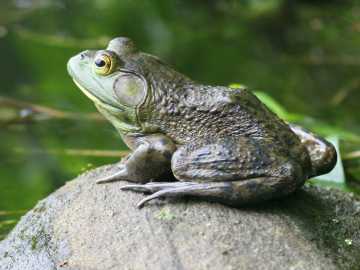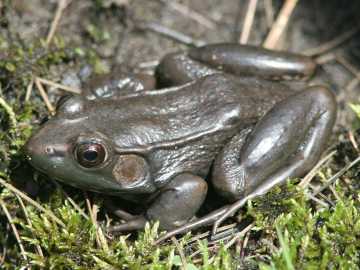

PHOTO COURTESY OF GARRY KESSLER
This bullfrog sits on a rock in a pond at the Mass Wildlife Management Area, waiting to capture an insect meal. You can tell it’s a male because the large round ear spot (behind and a little below the eye) is bigger than the eye. In females, the ear spot is smaller than the eye.
September 7, 2007, Page 5, 7
NATURE NOTES
By ANNIE REID
Westborough Community Land Trust
Bullfrogs in our ponds
In the last summery weeks of September, watch for native bullfrogs along trails that skirt weedy lakeshores.
American bullfrogs (Rana catesbeiana, Lithobates catesbeianus) are the biggest frogs you’ll find in our area. They can grow to half a foot long or so and weigh a pound or more. Their long legs, designed for great leaps, add another 6 or 7 inches to their length. Females are larger than males.
Both bullfrogs and green frogs (Rana clamitans) are usually green or olive in color. They can be hard to tell apart unless you get a good look. Green frogs are smaller, only about 2-4 inches long, but might be confused with a small bullfrog. To tell which one you’re looking at, look at the ridges on the frog’s back, as the photos show.
As you walk near a shore, you may hear a big plop! as a bullfrog leaps into the water. (At this time of year, the breeding season is over so you’re not likely to hear a chorus of calls.) Bullfrogs can leap up to 15 times their body length – perhaps 7-8 feet. Like other frogs, they leap to catch food, escape danger, and travel on land.
Bullfrogs are our most water-loving frogs. We associate frogs with water, but many of the frogs we encounter in Westborough are on dry land – crossing the trail, or rustling in the leaves by the side of the trail. As tadpoles, they grow up in water, and as adults they breed in water, but most of our frogs actually spend much of their lives living and hunting in fields and woods. Not so with bullfrogs!
You’ll find bullfrogs along shallow, weedy lakeshores, particularly where plants are growing out of the water and overhanging the water. For this reason Mill Pond – a flood control reservoir – is a more likely place to see bullfrogs than Sandra Pond, our drinking water reservoir. The brush and vegetation get regularly cut back from the Sandra Pond shoreline.
Gilmore Pond is another good place to find bullfrogs. Keep an eye out for them where the trail crosses Jack Straw Brook as it drains the pond.
Another likely place is the pond in the middle of the Mass Wildlife Management Area (across the fields). There you can find bullfrogs sitting on rocks at the shoreline and even on lily pads, waiting to snatch insects out of the air with their long tongues.

PHOTO COURTESY OF GARRY KESSLER
This green frog might be mistaken for a small bullfrog, but note the long ridge running down its back, all the way from the eye to the hind legs. In contrast, bullfrogs have a short ridge that curves around the ear spot, from the eye to the front leg, as the other photo shows.
Bullfrogs eat more than just mosquitoes, dragonflies, and other insects. They’re famous for their large appetites and will eat anything that moves. They hunt both day and night. Besides insects, they eat fish, leeches, tadpoles, salamanders, other frogs (even other bullfrogs), crayfish, snakes, ducklings, young turtles, worms, mice, and bats.
Of course, bullfrogs themselves have a place in nature’s food web. Their size makes them great predators but also a nice catch for the great blue herons and green herons that hunt in the shallows along pond shores. Bullfrogs also need to avoid becoming a meal for large fish, snapping turtles, snakes, skunks, and raccoons.
People have also been known to eat bullfrogs. (Frogs’ legs, anyone?) Many states, including Massachusetts, have an official hunting season and a bag limit for bullfrogs. People also catch them to use as for bait.
What do bullfrogs do in the winter? They hibernate. In October, as the weather and the water cool, they’ll bury themselves in the mud at the bottom of a pond, where they won’t freeze. The wood frogs that breed in our vernal pools and the spring peepers that call loudly in early spring have body chemistry than equips them to survive freezing, but bullfrogs don’t.
Like other amphibians, bullfrogs are “cold-blooded,” so they don’t keep their bodies at a certain temperature the way we do. Their body processes slow as their body temperature drops. In this condition they need less oxygen, and they absorb what they need through their skin and the lining of their mouth during hibernation.
If you spot bullfrogs in the weeks ahead, plan to check the same area next spring. In April they’ll emerge from hibernation eager to eat and breed. Males claim and defend a territory along the shore, and females choose a male for his territory. In June and July, the males’ loud chorus of calls – “jug-o-rum” – will help you find them.
Once bullfrog eggs are laid, the tadpoles hatch promptly – in four days or so – but then take a long time to develop. A year or more can pass before they transform into frogs. This lengthy time helps them to grow large.
Bullfrog tadpoles are just as voracious as the adult bullfrogs. They feed mostly on plant matter but also on tadpoles of other frogs. Their own skin is distasteful to fish, giving them some protection. They also tend to remain still in the water, so they don’t attract the attention of predators.
As the tadpoles become frogs, many dramatic changes take place. They grow legs and lose their tail. Lungs replace their gills. The tadpoles have a long intestine, needed for digesting plant foods, but it becomes a shorter intestine, suitable for digesting animal foods.
How have bullfrogs fared in the face of changes humans make in the environment? They’ve done quite well, as it turns out. Development often brings warmer water and increased plant growth (due to fertilizers and other chemicals in runoff) to local ponds, but these changes suit bullfrogs. On the other hand, pollution with toxic chemicals is always a problem for frogs and other amphibians, with their thin, porous skin.
Bullfrogs are native to our area and much of the eastern U.S., but it’s a different story west of the Mississippi. They have actually become an invasive species in Colorado and California, where they have displaced native species. They’re such effective predators that they eat the native frogs in these areas, as well as the native frogs’ food. And there they have few predators of their own.
Date index
Month (September)
Common name index
Scientific name index
Category index